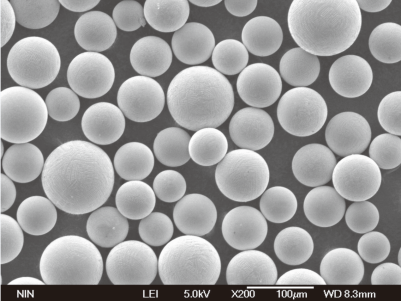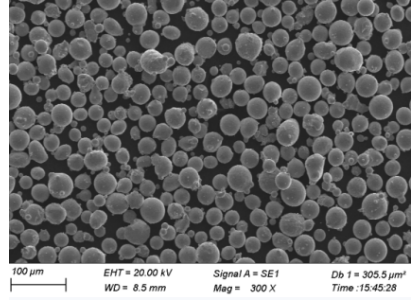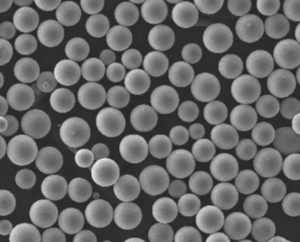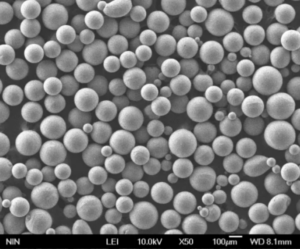لمحة عامة
معالجة ما بعد الذرة تعد معالجة مساحيق المعادن أمرًا بالغ الأهمية في عملية التصنيع لمجموعة متنوعة من الصناعات، من الفضاء إلى الأجهزة الطبية. تعمل هذه العملية على تحسين خصائص مساحيق المعادن، مما يجعلها أكثر ملاءمة لتطبيقات معينة. تتضمن المعالجة عادةً عمليات مثل التلدين والغربلة وتعديل السطح لتحسين توزيع حجم الجسيمات، والشكل، والتركيب الكيميائي.
ما هي معالجة ما بعد الذرة؟
تشير معالجة ما بعد الذرة إلى الطرق المختلفة المطبقة على مساحيق المعادن بعد إنتاجها من خلال الذرة. الذرة هي العملية التي يتم فيها تقسيم المعدن المصهور إلى قطرات دقيقة تتصلب بعد ذلك إلى جزيئات مسحوق. تعتبر معالجات ما بعد الذرة ضرورية لتحسين خصائص المسحوق، وضمان الاتساق، وتحسين الأداء في تطبيقات الاستخدام النهائي.

أنواع مساحيق المعادن وتركيبها
تأتي مساحيق المعادن في أنواع مختلفة، ولكل منها تركيبات وخصائص فريدة مصممة خصيصًا لتطبيقات معينة. فيما يلي بعض مساحيق المعادن الأكثر استخدامًا وتركيباتها:
| المسحوق المعدني | التركيب | الخصائص |
|---|---|---|
| فولاذ مقاوم للصدأ 316L | الحديد، الكروم، النيكل، المونيوم | مقاومة التآكل، قوة شد عالية |
| التيتانيوم Ti6Al4V | Ti، Al، V | نسبة عالية من القوة إلى الوزن ومقاومة التآكل |
| ألومنيوم 6061 | الألومنيوم، المغنيسيوم، السيليكون | خفة الوزن وخصائص ميكانيكية جيدة |
| سبيكة الكوبالت والكروم | كولورادو، كروم، مو | مقاومة عالية للتآكل، توافق حيوي ممتاز |
| سبيكة النيكل 625 | النيكل، الكروم، المونيوم، النحاس الأصفر | قوة عالية، مقاومة ممتازة للتآكل |
| فولاذ مصهور 18Ni300 | الحديد، النيكل، الكوكس، المونيوم | قوة عالية وصلابة جيدة |
| سبائك النحاس C18150 | النحاس، الكروم، الزر | توصيلية عالية، مقاومة ممتازة للتآكل |
| كربيد التنجستن | مرحاض، شركة | صلابة فائقة، مقاومة للتآكل |
| انكونيل 718 | Ni, Cr, Fe, Nb, Mo | قوة عالية، مقاومة جيدة للأكسدة |
| سبيكة برونز CuSn12 | النحاس، سن | مقاومة جيدة للتآكل، قابلية تشغيل ممتازة |
خصائص المسحوق للمعالجة بعد الذرة
تم تصميم معالجات ما بعد الذرة لتحسين الخصائص المختلفة لمساحيق المعادن. إليك نظرة على بعض الخصائص الرئيسية:
| الخصائص | الوصف |
|---|---|
| توزيع حجم الجسيمات | يضمن التوحيد، مما يؤثر |
| علم الصرف | أشكال كروية أو غير منتظمة تؤثر على التدفق والتعبئة |
| مساحة السطح | يؤثر على التفاعل وسلوك التلبيد |
| النقاء | مستويات النقاء العالية تقلل من خطر التلوث |
| قابلية التدفق | يؤثر على سهولة التعامل والمعالجة |
| الكثافة الظاهرة | يؤثر على كفاءة التعبئة والتلبيد |
| مستويات الأكسدة | تقلل الأكسدة المنخفضة من الأداء في تطبيقات درجات الحرارة العالية |
تطبيقات المسحوق لـ معالجة ما بعد الذرة
الخصائص المحسنة للمساحيق المعدنية بعد الذرة تجعلها مناسبة لمجموعة واسعة من التطبيقات:
| طلب | الوصف |
|---|---|
| الفضاء | مكونات عالية القوة وخفيفة الوزن |
| السيارات | أجزاء المحرك، ومكونات ناقل الحركة |
| الأجهزة الطبية | الغرسات والأدوات الجراحية |
| قطاع الطاقة | شفرات التوربينات، خلايا الوقود |
| الإلكترونيات | أحبار موصلة، إدارة الحرارة |
| الأدوات | أدوات القطع، القوالب |
| التصنيع المضاف (الطباعة ثلاثية الأبعاد) | أشكال هندسية مخصصة ومعقدة، النماذج الأولية |






المواصفات والأحجام والدرجات والمعايير
عند اختيار المساحيق المعدنية لمعالجة ما بعد الذرة، من المهم مراعاة المواصفات والأحجام والدرجات والمعايير. إليك جدول تفصيلي للرجوع إليه:
| نوع المسحوق | نطاق الحجم (ميكرومتر) | الصف | المعايير |
|---|---|---|---|
| فولاذ مقاوم للصدأ 316L | 15-45, 45-105 | AISI 316L | ASTM A276، AMS 5653 |
| التيتانيوم Ti6Al4V | 15-45, 45-90 | الصف الخامس | أستم B348، أم أس 4928 |
| ألومنيوم 6061 | 20-63, 63-125 | AA 6061 | ASTM B209، AMS 4027 |
| سبيكة الكوبالت والكروم | 10-45, 45-90 | ASTM F75 | الأيزو 5832-4 ISO 5832-4 |
| سبيكة النيكل 625 | 15-53, 53-150 | UNS N06625 | أستم ب 446، أم أس 5666 |
| فولاذ مصهور 18Ni300 | 10-45, 45-105 | الصف 300 | أم أس 6514، أستم A538، أستم A538 |
| سبائك النحاس C18150 | 20-53, 53-150 | UNS C18150 | ASTM B606، RWMA Class 2 |
| كربيد التنجستن | 5-15, 15-45 | حاصلة على شهادة ISO 9001 | ISO 9001, ASTM B777، ISO 9001 |
| انكونيل 718 | 15-45, 45-105 | UNS N07718 | أستم ب 637، أم أس 5662 |
| سبيكة برونز CuSn12 | 20-63, 63-150 | UNS C90700 | ASTM B505، AMS 4880 |
تفاصيل الموردين والأسعار
يعد اختيار المورد المناسب أمرًا بالغ الأهمية للحصول على مساحيق معدنية عالية الجودة. إليك نظرة على بعض الموردين وتفاصيل التسعير الخاصة بهم:
| المورد | الموقع | المسحوق المعدني | السعر (دولار/كجم) |
|---|---|---|---|
| هوغاناس إيه بي | السويد | فولاذ مقاوم للصدأ 316L | $50 – $70 |
| تقنية LPW | المملكة المتحدة | التيتانيوم Ti6Al4V | $300 – $400 |
| تكنولوجيا النجار | الولايات المتحدة الأمريكية | ألومنيوم 6061 | $25 – $40 |
| أركام إيه بي (GE Additive) | السويد | سبيكة الكوبالت والكروم | $250 – $350 |
| ساندفيك | السويد | سبيكة النيكل 625 | $100 – $150 |
| GKN Hoeganaes | الولايات المتحدة الأمريكية | فولاذ مصهور 18Ni300 | $150 – $200 |
| أميتك للمعادن المتخصصة | الولايات المتحدة الأمريكية | سبائك النحاس C18150 | $30 – $50 |
| كيناميتال | الولايات المتحدة الأمريكية | كربيد التنجستن | $70 – $90 |
| مسحوق المعادن والعملية | الولايات المتحدة الأمريكية | انكونيل 718 | $200 – $250 |
| صناعة المساحيق المعدنية | المملكة المتحدة | سبيكة برونز CuSn12 | $20 – $35 |
إيجابيات وسلبيات المسحوق لمعالجة ما بعد الذرة
لكل مسحوق معدني مجموعته الخاصة من المزايا والقيود. إليك نظرة مقارنة:
| المسحوق المعدني | مزايا | محددات |
|---|---|---|
| فولاذ مقاوم للصدأ 316L | مقاوم للتآكل، قوة عالية | تكلفة أعلى مقارنة بالفولاذ الأخرى |
| التيتانيوم Ti6Al4V | خفيفة الوزن وعالية القوة | باهظة الثمن وصعبة المعالجة |
| ألومنيوم 6061 | خفة الوزن وخصائص ميكانيكية جيدة | قوة أقل مقارنة بالفولاذ |
| سبيكة الكوبالت والكروم | مقاومة عالية للتآكل، متوافقة حيوياً | باهظ الثمن، يصعب تشغيله |
| سبيكة النيكل 625 | مقاومة ممتازة للتآكل، قوة عالية | باهظ الثمن، كثافة عالية |
| فولاذ مصهور 18Ni300 | قوة عالية وصلابة جيدة | باهظة الثمن، تتطلب معالجة حرارية |
| سبائك النحاس C18150 | توصيل عالي، مقاومة التآكل | عرضة للأكسدة، قوة أقل من الفولاذ |
| كربيد التنجستن | شديد الصلابة، مقاوم للتآكل | هش وباهظ الثمن |
| انكونيل 718 | قوة عالية، مقاومة جيدة للأكسدة | باهظة الثمن وصعبة التشغيل الآلي |
| سبيكة برونز CuSn12 | مقاومة جيدة للتآكل، قابلة للتشغيل | قوة أقل مقارنة بالسبائك الأخرى |
مزايا المسحوق لمعالجة ما بعد الذرة
توفر معالجة ما بعد الذرة فوائد عديدة تعمل على تحسين جودة وأداء المساحيق المعدنية. إليك نظرة تفصيلية على المزايا:
تحسين توزيع حجم الجسيمات
تساعد معالجات ما بعد الذرة مثل الغربلة والتصنيف في تحقيق توزيع موحد لحجم الجسيمات، وهو أمر بالغ الأهمية لتحقيق أداء متسق في تطبيقات مثل التصنيع الإضافي وتعدين المساحيق.
تحسين الشكل
يمكن للمعالجات مثل التلدين والمعالجة الحرارية أن تحسن شكل جزيئات المسحوق، مما يجعلها أكثر كروية. تتدفق الجسيمات الكروية بشكل أفضل، وتتراكم بكفاءة أكبر، وتنتج منتجات نهائية عالية الجودة.
تقليل التلوث
تعتبر المساحيق عالية النقاء مع الحد الأدنى من التلوث ضرورية لتطبيقات مثل الأجهزة الطبية ومكونات الفضاء. تضمن معالجات ما بعد الذرة أن المساحيق تفي بمتطلبات النقاء الصارمة.
تحسين القدرة على التدفق
تعد القدرة الجيدة على التدفق أمرًا بالغ الأهمية لعمليات مثل الطباعة ثلاثية الأبعاد وقولبة حقن المعادن.
تعمل معالجات ما بعد الذرة على تحسين خصائص تدفق المساحيق، مما يضمن معالجة سلسة وموثوقة.
مستويات الأكسدة المتحكم بها
يعد التحكم في مستويات الأكسدة للمساحيق المعدنية أمرًا ضروريًا لتطبيقات درجات الحرارة العالية. تساعد معالجات ما بعد الذرة في تقليل الأكسدة، وبالتالي تحسين أداء وعمر المنتجات النهائية.
المواصفات والأحجام والدرجات والمعايير الخاصة بالمسحوق لـ معالجة ما بعد الذرة
يتضمن اختيار المسحوق المعدني المناسب مراعاة المواصفات والأحجام والدرجات والمعايير المختلفة. إليك تفصيل تفصيلي:
| المسحوق المعدني | نطاق الحجم (ميكرومتر) | الصف | المعايير |
|---|---|---|---|
| فولاذ مقاوم للصدأ 316L | 15-45, 45-105 | AISI 316L | ASTM A276، AMS 5653 |
| التيتانيوم Ti6Al4V | 15-45, 45-90 | الصف الخامس | أستم B348، أم أس 4928 |
| ألومنيوم 6061 | 20-63, 63-125 | AA 6061 | ASTM B209، AMS 4027 |
| سبيكة الكوبالت والكروم | 10-45, 45-90 | ASTM F75 | الأيزو 5832-4 ISO 5832-4 |
| سبيكة النيكل 625 | 15-53, 53-150 | UNS N06625 | أستم ب 446، أم أس 5666 |
| فولاذ مصهور 18Ni300 | 10-45, 45-105 | الصف 300 | أم أس 6514، أستم A538، أستم A538 |
| سبائك النحاس C18150 | 20-53, 53-150 | UNS C18150 | ASTM B606، RWMA Class 2 |
| كربيد التنجستن | 5-15, 15-45 | حاصلة على شهادة ISO 9001 | ISO 9001, ASTM B777، ISO 9001 |
| انكونيل 718 | 15-45, 45-105 | UNS N07718 | أستم ب 637، أم أس 5662 |
| سبيكة برونز CuSn12 | 20-63, 63-150 | UNS C90700 | ASTM B505، AMS 4880 |
تحليل مقارن: أنواع المساحيق لمعالجة ما بعد الذرة
دعنا نتعمق في مقارنة تفصيلية للمساحيق المعدنية المختلفة:
الفولاذ المقاوم للصدأ 316L مقابل سبائك التيتانيوم Ti6Al4V
فولاذ مقاوم للصدأ 316L معروف بمقاومته للتآكل وقوته. ومع ذلك، التيتانيوم Ti6Al4V أخف وزنًا وله نسبة قوة إلى وزن أعلى، مما يجعله مثاليًا لتطبيقات الفضاء والطبية حيث يكون الوزن عاملاً حاسمًا.
سبائك الألومنيوم 6061 مقابل سبائك الكوبالت والكروم
ألومنيوم 6061 يوفر خصائص ميكانيكية جيدة وخفيف الوزن، لكنه لا يضاهي مقاومة التآكل والتوافق الحيوي لـ سبيكة الكوبالت والكروم، والذي يفضل استخدامه في الغرسات الطبية وتطبيقات طب الأسنان.
سبائك النيكل 625 مقابل فولاذ ماراجينج 18Ni300
سبيكة النيكل 625 ممتاز للبيئات ذات درجات الحرارة العالية والبيئات المسببة للتآكل نظرًا لمقاومته الفائقة للأكسدة. من ناحية أخرى، فولاذ مصهور 18Ni300 يوفر قوة وصلابة استثنائية، مما يجعله مناسبًا للأدوات والتطبيقات الهيكلية.
سبائك النحاس C18150 مقابل كربيد التنجستن
سبائك النحاس C18150 يتفوق في التوصيل الكهربائي ومقاومة التآكل، مما يجعله مثاليًا للتلامسات الكهربائية. في المقابل، كربيد التنجستن لا مثيل له في الصلابة ومقاومة التآكل، وهو مثالي لأدوات القطع وأجزاء التآكل.
Inconel 718 مقابل سبائك البرونز CuSn12
انكونيل 718 يفضل استخدامه لقوته العالية ومقاومته الجيدة للأكسدة في البيئات القاسية. سبيكة برونز CuSn12، مع قابليته الممتازة للتشغيل ومقاومته للتآكل، يستخدم بشكل شائع في المحامل والبطانات.
آراء ودراسات الخبراء
تعزز الدراسات وآراء الخبراء أهمية معالجة ما بعد الذرة في تحقيق الخصائص المطلوبة للمساحيق المعدنية. تشير الأبحاث إلى أن توزيع حجم الجسيمات والشكل الأمثل يؤثران بشكل كبير على أداء المساحيق في التصنيع الإضافي والتطبيقات الأخرى.
على سبيل المثال، تسلط دراسة أجرتها الجمعية الأمريكية للاختبارات والمواد (ASTM) الضوء على دور معالجات ما بعد الذرة في تقليل المسامية وتعزيز الخصائص الميكانيكية للأجزاء المطبوعة ثلاثية الأبعاد. وبالمثل، يؤكد الخبراء من اتحاد صناعات مسحوق المعادن (MPIF) على الحاجة إلى مساحيق عالية النقاء في التطبيقات الهامة مثل الفضاء والأجهزة الطبية.

أسئلة وأجوبة
| سؤال | الإجابة |
|---|---|
| ما هي معالجة ما بعد الذرة؟ | تشير معالجة ما بعد الذرة إلى عمليات مثل التلدين والغربلة وتعديل السطح المطبقة على المساحيق المعدنية بعد الذرة لتعزيز خصائصها. |
| لماذا يعتبر توزيع حجم الجسيمات مهمًا؟ | يضمن توزيع حجم الجسيمات الموحد القدرة على التدفق والكثافة والتعبئة والأداء العام في تطبيقات مختلفة مثل الطباعة ثلاثية الأبعاد وتعدين المساحيق. |
| ما هي فوائد شكل المسحوق الكروي؟ | تتدفق المساحيق الكروية بشكل أفضل، وتتراكم بكفاءة أكبر، وتنتج منتجات نهائية عالية الجودة مقارنة بالمساحيق ذات الأشكال غير المنتظمة. |
| كيف تقلل معالجة ما بعد الذرة من التلوث؟ | تساعد المعالجات مثل الغربلة والمعالجة الحرارية على إزالة الشوائب والملوثات، مما يضمن مساحيق عالية النقاء مناسبة للتطبيقات الهامة. |
| ما هو المسحوق المعدني الأفضل لتطبيقات الفضاء؟ | يفضل استخدام التيتانيوم Ti6Al4V لنسبة القوة إلى الوزن العالية ومقاومته الممتازة للتآكل، مما يجعله مثاليًا لمكونات الفضاء. |
| ما هي المزايا الرئيسية لاستخدام سبائك النيكل 625؟ | توفر سبائك النيكل 625 قوة عالية ومقاومة ممتازة للتآكل، خاصة في البيئات ذات درجات الحرارة العالية والبيئات المسببة للتآكل. |
| كيف يتم تحسين القدرة على التدفق للمساحيق المعدنية؟ | تعمل معالجات ما بعد الذرة مثل الغربلة والتلدين على تحسين خصائص تدفق المساحيق، مما يجعلها أسهل في التعامل والمعالجة. |
| ما هي أهمية مستويات الأكسدة في المساحيق المعدنية؟ | تعد مستويات الأكسدة المنخفضة أمرًا بالغ الأهمية لتطبيقات درجات الحرارة العالية، لأنها تعمل على تحسين أداء وعمر المنتجات النهائية. |
| هل يمكن لمعالجات ما بعد الذرة أن تحسن الخصائص الميكانيكية؟ | نعم، يمكن للمعالجات مثل التلدين والمعالجة الحرارية أن تعزز الخصائص الميكانيكية للمساحيق المعدنية، مما يجعلها أكثر ملاءمة لتطبيقات معينة. |
| ما هو المسحوق المعدني الأفضل للغرسات الطبية؟ | يستخدم سبائك الكوبالت والكروم بشكل شائع للغرسات الطبية نظرًا لمقاومته العالية للتآكل وتوافقه الحيوي الممتاز. |

